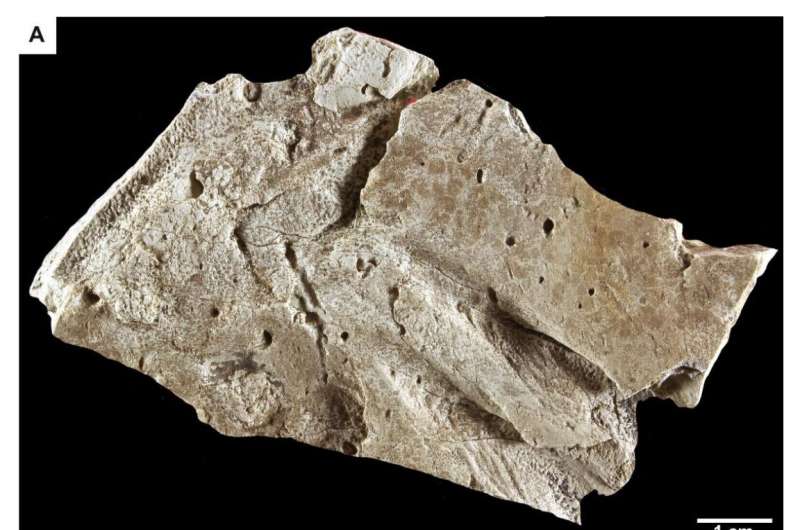This article has been reviewed according to Science X's editorial process and policies. Editors have highlighted the following attributes while ensuring the content's credibility:
fact-checked
peer-reviewed publication
trusted source
proofread
The earliest deep-sea vertebrates revealed by unusual trace fossils

Scientists have discovered a missing evolution puzzle piece in 130-million-year-old rocks. The discovery is a result of an international collaboration, in which the Faculty of Sciences of the University of Lisbon (Portugal) is involved.
While vertebrates are a prominent component of modern deep-sea ecosystems, there has been no fossil evidence of deep-sea fishes older than 50 million years. Now, the discovery of extremely rare fossils, representing the earliest evidence of deep-sea fishes, push back the invasion of the abyssal plain by 80 million years. These findings are now published in a new study on the Proceedings of the National Academy of Sciences (PNAS).
"When I first found the fossils, I could not believe what I was seeing," says paleontologist Andrea Baucon, leader of this study, researcher at the University of Genova (Italy). Baucon was the one who discovered the fish fossils in the northwest Apennines, close to Piacenza, Modena, and Livorno (Italy).
The reason for his astonishment is the remote age of the fossils, which predate any other evidence of deep-sea fish by million years. The newly discovered fossils date back to the Early Cretaceous (130 million years ago).
"The new fossils show the activity of fishes on a dinosaur-age sea floor that was thousands of meters deep," adds Baucon.
The newly discovered fossils are rare and unusual. They comprise bowl-shaped excavations produced by ancient feeding fishes, as well as the sinuous trail formed by the tail of a swimming fish, incising the muddy sea floor. These trace fossils do not include body fossils such as fish bones, but they record ancient behavior. As such, the Apennine fossils mark a critical point in space and time. It is the point at which fishes moved out of the continental shelf and colonized a new harsh environment, located far away from their original habitat.
Thousands of meters below the surface of the Tethys Ocean—an ancient ocean that existed between 250 and 50 million years ago, precursor of present-day Mediterranean Sea—the earliest deep-sea fishes faced extreme environmental conditions relative to their shallow water origins: total darkness, near-freezing temperatures and enormous pressures challenged the survival of these pioneers of the abyss.
Such extreme conditions required adaptations for deep-sea life that are evolutionary innovations as significant as those that allowed the colonization of the land and the air, such as wings and limbs, for example.
The newly discovered fossils represent not just the earliest deep-sea fishes but the earliest deep-sea vertebrates. The evolution of vertebrates—backboned animals—has been punctuated by habitat transitions from shallow marine origins to terrestrial, aerial and deep-sea environments. Invasion of the deep sea is the least-understood habitat transition because of the low fossilization potential associated with the deep sea.
"The new fossils shed light on an otherwise obscure chapter of the history of life on Earth," says Carlos Neto de Carvalho, researcher at Instituto Dom Luiz, Faculty of Sciences of the University of Lisbon (Ciências ULisboa) (Portugal).
The Apennine fossils force scientists to reconsider which factors might have triggered the vertebrate colonization of the deep sea. The authors propose that the trigger was the unprecedented input of organic matter that occurred between the Late Jurassic and the Early Cretaceous. The availability of food in the deep seas favored bottom-dwelling worms, which in turn attracted fishes that used specific behaviors to expose them.
In this study, researchers turned to present-day seas to understand fossil behavior, studying the behavior of modern fishes in their habitats. Scientists explored the depths of the Pacific Ocean to study chimeras, also known as ghost sharks, in their living environment.
The new fossils are identical to structures produced by modern fishes that feed by either scratching the sea floor or exposing their bottom-dwelling prey by suction. This is similar to the behavior of Neoteleostei, the group of vertebrates that includes modern jellynose fishes and lizard fishes.
"Contrarily to the common belief, the deep-sea floor sediments are packed with fossil remains of ancient life, but normally from small organisms that dwell well above in the water column as phyto or zooplankton," explains Mário Cachão, co-author of this study and researcher at Instituto Dom Luiz, Ciências ULisboa.
"However, to discover and interpret direct evidences of organic activity of vertebrates imprinted and geologically preserved in such sediments, after being tectonically deformed and exposed as the Northern Apennine mountain range, emplaced mostly during the Miocene and Pliocene geological epochs—that is, approximately the last 20 million years ago—is a very, very, rare find indeed," adds Cachão.
The newly discovered fossils may represent the first major step in the origins of modern deep-sea vertebrate biodiversity. The roots of modern deep-sea ecosystems are in the Apennine fossils, revealing information about a key habitat transition in the history of the oceans.
"Our fossil discoveries reassess the mode and tempo of the vertebrate colonization of the deep sea. The newly discovered fossils contain fundamental clues about the very beginnings of vertebrate evolution in the deep sea, having profound implications for both Earth and life sciences," summarizes Baucon.
More information: Andrea Baucon et al, The earliest evidence of deep-sea vertebrates, Proceedings of the National Academy of Sciences (2023). DOI: 10.1073/pnas.2306164120
Journal information: Proceedings of the National Academy of Sciences
Provided by University of Lisbon





















